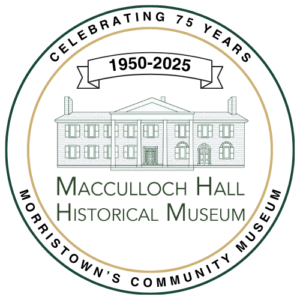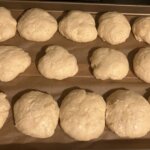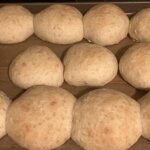This recipe for rusk is among the first recipes written in the 19th century Macculloch family cookbook. Rusk, bread that is baked twice, makes dried toast that lasts longer that bread baked once. Historically, this method provided a way to feed the army of Ancient Rome, who ate biscotus, and later Spanish and Portuguese sailors, who ate rosca, during long sea voyages. Since preservation methods were still limited in the 1700s and 1800s, rusk continued to be eaten, but more varieties were available. The Macculloch family recipe does not provide precise directions on how to bake the rusk, but other historic recipes’ instructions include shaping the dough into rolls or round cakes.
Miss Beecher’s Domestic Receipt Book, published in 1846 by Catharine Beecher (1800-1878), contains a recipe for Very Nice Rusk which provides similar instructions to the Macculloch family recipe, “flour enough to make it as thick as you can with a spoon.” By the 1830s people were eating rusk that were both soft, most likely only baked once, or hard rusk, which was baked twice. Rusk was also flavored in different ways, with rose-water, cinnamon, molasses, or nutmeg. Some 19th century recipes also called for rusk to be used as an ingredient in making a dessert.
The recipe below makes about a dozen delicious rolls, if baked only once, or two dozen toasts that can be enjoyed with soup or a warm beverage.
Rusk—Original
1 qt milk, warmed
Stir in as much flour as you can with a spoon. Then add yeast to stand till light. Then warm a quarter of a lb. of butter. A teaspoonful of salaratus & four eggs beaten light. Half of a large nutmeg and as much sugar as will make it sweet enough; then add more flour and let it rise again. Then work it up well and let it rise again.
Rusk—Adapted Recipe
1 cup milk, lukewarm about 100 degrees
4 cups all-purpose flour, sifted
1 pkge. instant yeast (2 ¼ teaspoons)
4 tablespoons butter, softened
½ cucharadita de bicarbonato de sodio
2 huevos
¼ nutmeg, freshly grated (about 1 teaspoon)
1/3 cup of sugar or to taste
Pour warmed milk into a large mixing bowl with dough hook, if available. Add half of the sifted flour then the yeast and combine. Add softened butter and baking soda then slightly beaten eggs one at a time. Mix ingredients. Add nutmeg and the remaining flour. Cover dough and let it rise for 2 hours. Next divide dough into small pieces and shape into 2 ½ inch round cakes. The dough will be slightly sticky so use a lightly-floured board. Place cakes on sprayed parchment paper on baking sheet about an inch apart. Cover lightly with plastic wrap sprayed with oil and let rise another 90 minutes.
Preheat oven to 350 degrees. Bake for 13-15 minutes, until golden brown. Internal temperature should be 190 degrees when ready. Take out of the oven and let cool on a baking rack overnight uncovered. Makes approximately one dozen.
Next day, preheat oven to 200 degrees. Cut cakes in half and place on baking sheet. Bake for one hour. If you prefer a sweeter toast, you can add a sugar and cinnamon topping to the second side. Flip slices over and bake for one additional hour. Remove from oven and let cool.
The website Revolutionary Pie provides a thorough history of Rusk: Rusks and Zwieback | Revolutionary Pie
For more Rusk recipes, visit: Rusks, Early Documentation | Thehistoricfoodie’s Blog (wordpress.com)

Tema: El lunes de la comida
Edad / Nivel: Bachillerato, Universidad, Aprendizaje a lo largo de la vida



